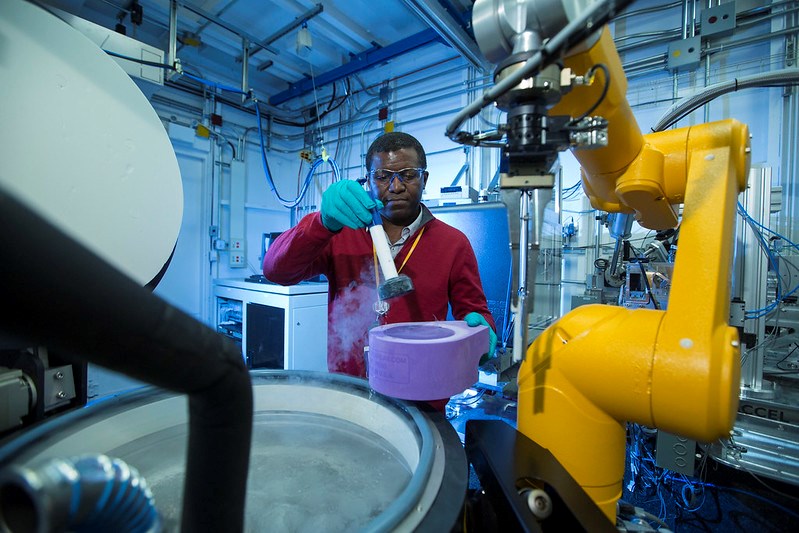SASKATOON – The rapid development of safe and effective vaccines has helped bring the pandemic under control. However, with the rise of variants and an uneven global distribution of vaccines, COVID-19 is a disease we will have to manage for some time.
Antiviral drugs that target the way the virus replicates may be the best option for treating outbreaks of COVID-19 in unvaccinated and under-vaccinated populations.
Using the Canadian Light Source (CLS) at the University of Saskatchewan, researchers from the University of Alberta (U of A) have isolated some promising inhibitors that could be used to treat COVID-19 infections. The scientists used the synchrotron remotely during the facility’s special COVID-19 call for proposals, an initiative created to support research to help fight the pandemic.
The team’s findings have been recently published in the European Journal of Medicinal Chemistry.
“With the help of the CLS, and the multiple teams here at the U of A, including the our lab and the Young lab in the Department of Biochemistry, Vederas lab in the Department of Chemistry, and Tyrrell team in Medical Microbiology and Immunology Department, we've been very efficient at developing a group of inhibitors that is very promising,” said Joanne Lemieux, a professor at the U of A.
The synchrotron creates light millions of times brighter than the sun that helps researchers to find very detailed information about their samples. Lemieux and colleagues used the CMCF beamline at the CLS to search for molecules that could stop SARS-CoV-2 — the virus that causes COVID-19 — from replicating inside human cells.
The team found inhibitors that target a special kind of protein called a protease, which is used by the virus to make more copies of itself. Proteases act like an axe and help the virus chop up large proteins. Without this protein, the virus would be unable to multiply and harm human health.
“One of the inhibitors that we used as our benchmark starting point was one that was developed to treat a feline coronavirus,” Lemieux said. “This was not an optimal inhibitor given the dosage for humans, which is why new derivatives needed to be made in order to provide patients with a lower dosage.”
While SARS-CoV-2 and its cousins SARS and MERS cause serious respiratory diseases, coronaviruses are also responsible for a wide range of illnesses in humans and animals. Lemieux stated that the proteases are very similar among the different coronaviruses.
“It's likely that any antiviral that is developed for one coronavirus would also be a broad specificity inhibitor that could treat a variety of coronavirus infections, including those found in animals,” Lemieux said.
Over the past decade, oral antiviral medication has become more accessible to patients in need. There are oral protease inhibitors that treat and manage symptoms for diseases like HIV and Hepatitis C. This research team wants to help make SARS-CoV-2 inhibitors available in a pill form, which would make it easier to treat COVID-19.
Lemieux’s team is not alone in their quest for antivirals that will help treat diseases like COVID-19. Pfizer, the pharmaceutical company behind the successful mRNA vaccine, is moving its antivirals to stage one clinical trials. Lemieux sees this as a sign that her group has been headed in the right direction.
“With many people working around the world developing antivirals targeting proteases, there is very likely to be one or more antivirals on the market,” Lemieux said. “This would enable ease of accessibility for people around the world, especially in regions or populations where vaccines are not an option.”
Without the help of the synchrotron, Lemieux says their research would be incomplete. CLS technology allows scientists to visualize how drug candidates work at the molecular level. “It’s crucial in optimizing drug development,” she said.
“The personnel at CLS have been extremely helpful, especially during the pandemic when things had to be conducted remotely. It's wonderful to have this facility here in Canada, enhancing the international reputation of Canadian research,” Lemieux said.
The Canadian Light Source at the University of Saskatchewan is a national research facility, producing the brightest light in Canada—millions of times brighter than even the sun. One of the largest science projects in our country’s history, the CLS hosts annually more than 1,000 scientists from around the world who use thelight to conduct ground-breaking health, agricultural, environmental and advanced materials research.
The Canada Foundation for Innovation, Natural Sciences and Engineering Research Council, National Research Council of Canada, Canadian Institutes of Health Research, the Government of Saskatchewan and the University of Saskatchewan fund its operations.





